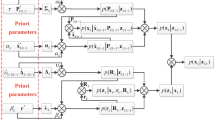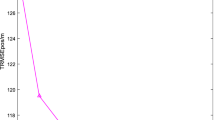Abstract
A new heavy-tailed robust Kalman filter is presented to address the issue that the linear stochastic state-space model has heavy-tailed noise with time-varying process bias. The one-step predicted probability density function (PDF) is modeled as the Student’s-t-inverse-Wishart distribution, and the likelihood PDF is modeled as the Student’s-t distribution. To acquire the approximate joint posterior PDF, the conjugate prior distributions of the state vector and auxiliary variables are set as the Gaussian, the inverse-Wishart, the Gaussian-Gamma, and the Gamma distributions, respectively. A new Gaussian hierarchical state-space model is presented by introducing auxiliary variables. Based on the proposed Gaussian hierarchical state-space model, the parameters of the proposed heavy-tailed robust filter are jointly inferred using the approach of the variational Bayesian. The simulation illustrates that the time-varying process bias is adaptively real-time estimated in this paper. In comparison with the existing cutting-edge filters, the presented heavy-tailed robust filter obtains higher accuracy.






Similar content being viewed by others
Data Availability Statement
The datasets generated during the current study are available from the corresponding author on reasonable request.
Abbreviations
- KF:
-
Kalman filter
- SSM:
-
State-space model
- HPMN:
-
Heavy-tailed process and heavy-tailed measurement noises
- PDF:
-
Probability density function
- HKF:
-
Huber KF
- MCCKF:
-
Maximum Correntropy Criterion KF
- RSTKF:
-
Robust Student’s-t KF
- PRKF:
-
Proposed robust KF
- VB:
-
Variational Bayesian
- KLD:
-
Kullback–Leibler divergence
- RMSE:
-
Root mean square error
- ARMSE:
-
Averaged root mean square error
- IW:
-
Inverse-Wishart
- STIW:
-
Student’s-t-inverse-Wishart
- dof:
-
Degree of freedom
- \(\mathbf {y}_{i:j} \triangleq \{\mathbf {y}_k|i \le k \le j\}\) :
-
measurement of time from i to j
- \(N(\cdot ;\mu , \varSigma )\) :
-
Gaussian PDF with mean vector \(\mu \) and covariance matrix \(\varSigma \)
- \({\text {IW}}(\cdot ;\nu , \varPsi )\) :
-
IW PDF with dof \(\nu \) and inverse scale matrix \(\varPsi \)
- \({\text {STIW}}(\cdot ;\mu ,\varPsi ,t,T,\tau )\) :
-
STIW PDF with the location vector \(\mu \), the scale matrices \(\varPsi \) and T, the dof parameter t and \(\tau \), respectively
- \({\text {St}}(\cdot ;\mu ,\varSigma ,\tau )\) :
-
Student’s-t PDF with the mean vector \(\mu \), the scale matrix \(\varSigma \) and the dof parameter \(\tau \)
- \(G(\cdot ;\alpha ,\beta )\) :
-
Gamma PDF with shape parameter \(\alpha \) and rate parameter \(\beta \)
- log:
-
Natural logarithm
- exp:
-
Natural exponential
- \(E_{x}{[}\cdot {]}\) :
-
Expectation of x
- \(E^{(i)}{[}\cdot {]}\) :
-
Expectation at the ith iteration
- \(q^{(i)}(\cdot )\) :
-
Approximation PDF \(q(\cdot )\) at the ith iteration
- \({\text {trace}}(\cdot )\) :
-
Trace of a matrix
- \(\mathbf{I} _n\) :
-
\(n \times n\) identity matrix
- \(\mathbf {A}^{-1} \) :
-
Inverse of \(\mathbf {A}\)
- \(\mathbf {A}^{\mathrm{T}}\) or \(\mathbf {x}^\mathrm{T} \) :
-
Transpose of \(\mathbf {A}\) or \(\mathbf {x}\)
References
A. Almagbile, J. Wang, W. Ding, Evaluating the performances of adaptive Kalman filter methods in gps/ins integration. J Glob Position Syst 9(1), 33–40 (2010)
C.M. Bishop, Pattern Recognition and Machine Learning (Springer, 2006)
B. Chen, X. Liu, H. Zhao, J.C. Principe, Maximum correntropy Kalman filter. Automatica 76, 70–77 (2017)
J.J. Deyst, J.C. Deckert, RCS jet failure identification for the space shuttle. IFAC Proc. Volumes 8(1), 428–435 (1975)
B. Feng, M. Fu, H. Ma, Y. Xia, B. Wang, Kalman filter with recursive covariance estimation-sequentially estimating process noise covariance. IEEE Trans. Ind. Electron. 61(11), 6253–6263 (2014)
Y. Huang, G. Jia, B. Chen, Y. Zhang, A new robust Kalman filter with adaptive estimate of time-varying measurement bias. IEEE Signal Process. Lett. 27, 700–704 (2020)
Y. Huang, Y. Zhang, N. Li, Z. Wu, J.A. Chambers, A novel robust student’s t-based Kalman filter. IEEE Trans. Aerosp. Electron. Syst. 53(3), 1545–1554 (2017)
Y. Huang, Y. Zhang, Z. Wu, N. Li, J. Chambers, A novel adaptive Kalman filter with inaccurate process and measurement noise covariance matrices. IEEE Trans. Autom. Control 63(2), 594–601 (2017)
Y. Huang, Y. Zhang, Y. Zhao, J.A. Chambers, A novel robust gaussian-student’s t mixture distribution based Kalman filter. IEEE Trans. Signal Process. 67(13), 3606–3620 (2019)
R. Izanloo, S.A. Fakoorian, H.S. Yazdi, D. Simon, in Kalman Filtering based on the Maximum Correntropy Criterion in the Presence of Non-Gaussian Noise. (IEEE, 2016), pp. 500–505
G. Jia, Y. Huang, Y. Zhang, J. Chambers, A novel adaptive Kalman filter with unknown probability of measurement loss. IEEE Signal Process. Lett. 26(12), 1862–1866 (2019)
G. Jia, Y. Zhang, M. Bai, N. Li, J. Qian, A novel robust student’s t-based gaussian approximate filter with one-step randomly delayed measurements. Signal Process. 171, 107496 (2020)
C.D. Karlgaard, H. Schaub, Huber-based divided difference filtering. J. Guid. Control Dyn. 30(3), 885–891 (2007)
N. Li, Bai, M.m., Zhang, Y.g, et al., A novel student’s t-based kalman filter with colored measurement noise. Circuits, Systems, and Signal Processing, 1–18 (2020)
L. Luo, Y. Zhang, T. Fang, N. Li, A new robust Kalman filter for sins/dvl integrated navigation system. IEEE Access 7, 51386–51395 (2019)
M. Roth, E. Özkan, F. Gustafsson, in A student’s t filter for heavy tailed process and measurement noise. (IEEE, 2013), pp. 5770–5774
S. Sarkka, A. Nummenmaa, Recursive noise adaptive kalman filtering by variational bayesian approximations. IEEE Transactions on Automatic Control 54(3), 596–600 (2009)
C. Shan, W. Zhou, Y. Yang, Z. Jiang, Multi-fading factor and updated monitoring strategy adaptive Kalman filter-based variational Bayesian. Sensors 21(1), 198 (2021)
D. Simon, Optimal State Estimation: Kalman, H Infinity, and Nonlinear Approaches (John Wiley & Sons, 2006)
F.M. Sobolic, D.S. Bernstein, in Kalman-filter-based time-varying parameter estimation via retrospective optimization of the process noise covariance. (IEEE, 2016), pp. 4545–4550
D.G. Tzikas, A.C. Likas, N.P. Galatsanos, The variational approximation for Bayesian inference. IEEE Signal Process. Mag. 25(6), 131–146 (2008)
S.Y. Wang, C. Yin, S.K. Duan, L.D. Wang, A modified variational Bayesian noise adaptive Kalman filter. Circuits Syst. Signal Process. 36(10), 4260–4277 (2017)
Z. Wang, W. Zhou, Robust linear filter with parameter estimation under student-t measurement distribution. Circuits Syst. Signal Process. 38(6), 2445–2470 (2019)
A.S. Willsky, A survey of design methods for failure detection in dynamic systems. Automatica 12(6), 601–611 (1976)
D. Xu, Z. Wu, Y. Huang, A new adaptive Kalman filter with inaccurate noise statistics. Circuits Syst. Signal Process. 38(9), 4380–4404 (2019)
S. Zhao, B. Huang, F. Liu, Linear optimal unbiased filter for time-variant systems without apriori information on initial conditions. IEEE Trans. Autom. Control 62(2), 882–887 (2016)
S. Zhao, B. Huang, Y.S. Shmaliy, Bayesian state estimation on finite horizons: the case of linear state-space model. Automatica 85, 91–99 (2017)
S. Zhao, Y.S. Shmaliy, F. Liu, Fast Kalman-like optimal unbiased fir filtering with applications. IEEE Trans. Signal Process. 64(9), 2284–2297 (2016)
B. Zhu, L. Chang, J. Xu, F. Zha, J. Li, Huber-based adaptive unscented Kalman filter with non-gaussian measurement noise. Circuits Syst. Signal Process. 37(9), 3842–3861 (2018)
Acknowledgements
Thanks very much for the help of the editor and reviewers to improve the quality of our manuscript. Not only that, some of the valuable comments you put forward will make me do a better job in the future.
Author information
Authors and Affiliations
Corresponding author
Ethics declarations
Conflict of interest
The authors declare that they have no conflict of interest.
Additional information
Publisher's Note
Springer Nature remains neutral with regard to jurisdictional claims in published maps and institutional affiliations.
This work was supported in part by National Natural Science Foundation of China (Grant No. 61573113), and in part by the Ph.D. Student Research and Innovation Fund of the Fundamental Research Funds for the Central Universities under Grant 3072020GIP0409.
Appendices
Appendix A: Detailed Derivation of the Log Joint Posterior PDF
Using (16)–(18), (20)–(21) into (25), the joint posterior PDF \( p(\varTheta ,{\mathbf {y}}_{1:k})\) can be reformulated as follows
where the Gaussian PDF of a random vector of d dimension is given by [2]
and the inverse Wishart PDF of a symmetric positive definite random matrix B of \(\text {d} \times \text {d}\) dimension is given by [2]
where \(\varGamma (\cdot )\) denotes the Gamma function, and the Gamma PDF is given by [2]
Exploiting (58)–(60), and taking log operation to Eq. (57), the log joint posterior PDF is formulated as follows
Appendix B: Proof of the Proposition 2
Define the modified one-step predicted PDF is \(p^{(i+1)}({\mathbf {x}}_k|{\mathbf {y}}_{1:k-1})\) as follows
similar to the modified one-step predicted PDF, define the modified likelihood PDF \(p^{(i+1)}({\mathbf {y}}_k|{\mathbf {x}}_k)\) as follows
where \(\overline{{\mathbf {P}}}_{k|k-1}^{(i+1)}\) and \(\overline{{\mathbf {R}}}_k^{(i+1)}\) are the modified one-step predicted error covariance matrix and the modified measurement noise covariance matrix, which is as follows
Using (62)–(65) in (31), we obtain
where \(c_k^{(i+1)}\) is the normalizing constant, which is as follows
Appendix C: Proof of the Proposition 3
Using (37), the \({\text {log}}q^{(i+1)}({\varvec{\psi }}_k,\xi _k)\) can be rewritten as follows
To derive the approximate posterior PDF of the time-varying process bias, define the modified time-varying process bias and the corresponding error covariance as \(\widetilde{{\varvec{\psi }}}_k^{(i)}\) and \(\widetilde{{\varvec{{\Psi }}}}_k^{(i)}\), which is as follows
by inserting (69) and (70) into (68), Eq. (68) is reformulated as follows
Define prior and likelihood PDFs of the modified time-varying process bias as
using the Bayesian’s rule and the standard KF measurement-update stage, we have
where the likelihood PDF and posterior PDF of the modified time-varying process bias are calculated by
using (72)–(76) , (71) can be reformulated as follows
Appendix D: Calculation of the Complex Necessary Expectation
The expectation \({\mathbf {A}}_k^{(i)}\) in (27) can be calculated as follows
where \({\mathbf {P}}_{{\varvec{\psi }}_k}^{(i+1)}\) is obtained by
The expectation \({\mathbf {C}}_k^{(i)}\) in (37) can be calculated as follows
The expectation \({\mathbf {D}}_k^{(i)}\) in (45) can be calculated as follows
Rights and permissions
About this article
Cite this article
Jiang, Zh., Zhou, Wd., Jia, Gl. et al. A New Heavy-Tailed Robust Kalman Filter with Time-Varying Process Bias. Circuits Syst Signal Process 41, 2358–2378 (2022). https://doi.org/10.1007/s00034-021-01866-8
Received:
Revised:
Accepted:
Published:
Issue Date:
DOI: https://doi.org/10.1007/s00034-021-01866-8




